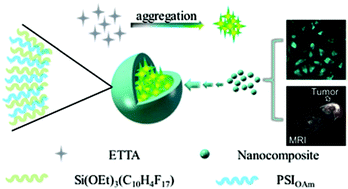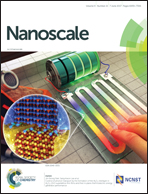Multifunctional nanoprobes for both fluorescence and 19F magnetic resonance imaging†
Abstract
Fluorescence is widely used for cell imaging due to its high sensitivity and rich color choice but limited for in vivo imaging because of its low light penetration. Meanwhile, magnetic resonance imaging (MRI) is widely applied for in vivo diagnosis but not suitable for cell imaging because of its low resolution. Compared to 1H-MRI, 19F-MRI is more suitable for clinical application due to its high sensitivity but fabricating 19F-MRI probes is a great challenge. Therefore, it is highly desirable to develop a dual-modal imaging probe for both cell fluorescence imaging and in vivo19F-MRI with high sensitivity and deep penetration. In this study, 19F moiety loaded nanocomposites with an organic fluorescent core were successfully prepared via a facile strategy by encapsulating organic dyes with oleylamine-functionalized polysuccinimide and 1H,1H,2H,2H-perfluorodecyltriethoxysilane (PDTES). The aggregation of organic fluorescent dyes in the core results in significant fluorescence for optical imaging, while the 19F moieties on PDTES allow for simultaneous 19F MRI. Moreover, the nanocomposites exhibited high water dispersibility and excellent biocompatibility. These properties make them promising for both cell imaging and in vivo imaging applications.



 Please wait while we load your content...
Please wait while we load your content...